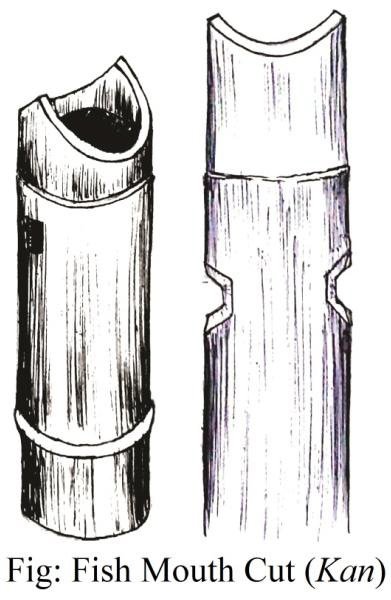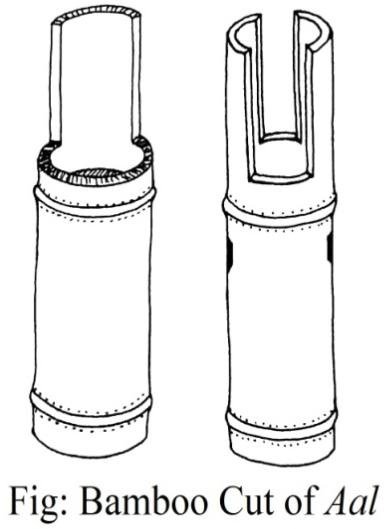Vernacular architecture of Assam
by Nabajit Deka | 2018 | 96,996 words
This study deals with the architecture of Assam (Northeastern India, Easter Himalayas), with special reference to Brahmaputra Valley. The Vernacular Architecture of Assam enjoys a variety of richness in tradition, made possible by the numerous communities and traditional cultures....
Techniques (d): Posts
The posts (khuta) of the house are made of bamboo or tree trunk. However, bamboo post is most extensively used in Assam. For the bamboo posts, straight and mature bamboo, ideally of bhaluka species, is preferred. However, the makal or jati species are also used for the purpose. The bottom portion of a bamboo is ideal for the post, and only one post, especially in case of main post, is sectioned from a bamboo. For the purpose, the bamboo is severed as per intended height of the house. It is necessary to slash the top side of the column few inches above the node to make groove.
 |
 |
The top end of the bamboo is then cut and fashioned in particular manner to facilitate the joinery process. Thus, different types of cuts in the bamboo end enables different joinery of members. The most common cut used in the post is the fish-mouth cut (kan). To make kan, the end of the bamboo is slashed in a slanting way both from opposite sides. This slashing in slanting direction creates a groove and two ears in the bamboo, which is called kan and the process is known as the kaniowa. After making the kan, the bamboo is notched below the ears and node through cutting away two small slices from the bamboo. Lacing is done passing the tying strand through these holes. The other cuts used are the “one ear” or “two ear” cuts known as aal. In this process known as aalkata, the bamboo is cut straight from both sides to a certain point. Then the severed portion is split away from the bamboo and there remain one or two pillars to hold another bamboo.
There may be number of khutas in the lengthwise direction of a house but there remain ideally five breadth wise posts. The five posts in the breadth wise side are traditionally known as:
1) Mudhar khuta (the middle one that supports the ridge bearing purlin);
2) Kumar / mootpochar / moorpachar khuta (the two posts on both sides of the previous);
3) Panpocha / panipotar khuta (the corner posts of the house);
The posts are carefully selected and subsequently processed to enhance the durability. Sometimes, the bottom side of post is burnt slightly (especially of wooden posts) to prevent the attack of white ant or termite while the pit is re-filled with sand (Dev Goswami:2005). Nowadays, the embedded portion is sometimes wrapped with polythene to prevent the early decaying or decomposing.
The bamboos are processed well through gorowa and subsequent drying in shade before using in the construction. Sometimes, smoke is also applied to materials. The bamboos are prepared through cutting of the twigs and smoothened well. The peel or the rind of the bamboo is usually not removed in case of post, rafter, and purlin. However, while making strand or weaving splints for door or the wall, the outer scale and the inner layers are removed. Usually, a ripened or withered bamboo is not used in the construction. The age or maturity of the bamboo is very crucial and critically examined before selection of the bamboo.
